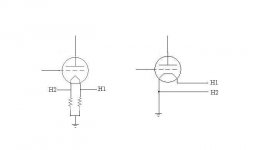the one with the resistors is supposed to in some way reduce the hum. i`m not really sure how it works, coud someone shed some light?
hi
just my practical experience with my last tube driver
but no exact explication
www.loginnovation.com/jeapel
with 6sn7 double triode half for right and half for left
1-without ground on heater big hum on speaker
2-with one ground zero hum on right and hum on left
3-with 2 100 ohm 1w very low hum on both channel 🙂
4-for my very low gain 6as7 no need of ground
100ohm 1 w is typical value my 6sn7 are low noise
electro harmonic but a cheap hummy tube maybe
50 ohm or 25 ohm with good watt
just my practical experience with my last tube driver
but no exact explication
www.loginnovation.com/jeapel
with 6sn7 double triode half for right and half for left
1-without ground on heater big hum on speaker
2-with one ground zero hum on right and hum on left
3-with 2 100 ohm 1w very low hum on both channel 🙂
4-for my very low gain 6as7 no need of ground
100ohm 1 w is typical value my 6sn7 are low noise
electro harmonic but a cheap hummy tube maybe
50 ohm or 25 ohm with good watt
1 is for AC heaters where the alternating voltage balances between the two nodes, minimizing grid-cathode hum. 2 is for DC filaments.
Tim
Tim
Hi,
With indirectly heated tubes and quite likely a center tapped heater xformer too....
Cheers, 😉
maybe but old radio use methode 2 with ac
With indirectly heated tubes and quite likely a center tapped heater xformer too....
Cheers, 😉
just my practical experience with my last tube driver
Nice amp! Got any pics? How many watts does it produce?
Back on topic, I have found most indirectly heated tubes have quite minimal hum.
Raising the heater supply above ground by a few volts, keeping in mind heater to cathode ratings, can also reduce hum. This is often necessary in SRPP-type designs.
- Status
- Not open for further replies.
- Home
- Amplifiers
- Tubes / Valves
- Different direct heating styles?
